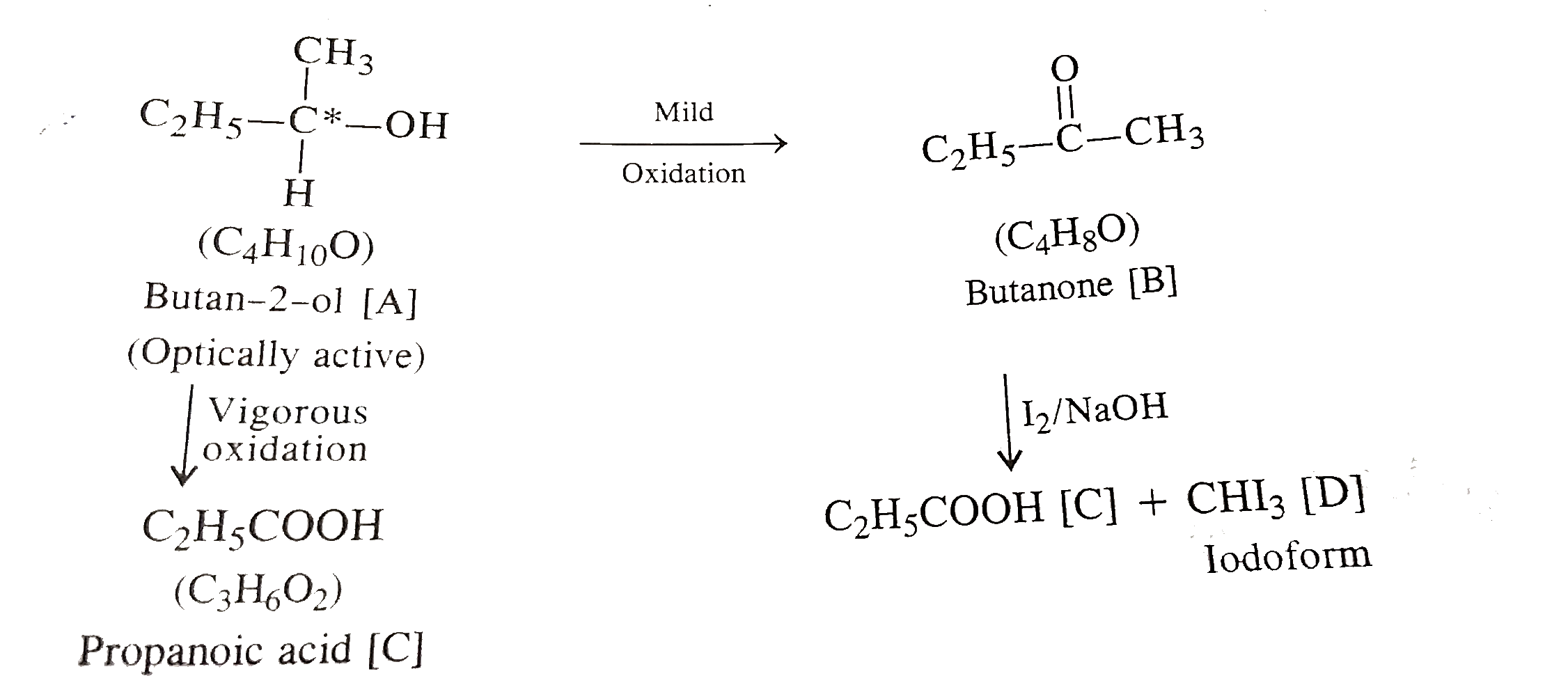An organic compound 'A'(C4H10O) is optically active. On mild oxidation, it gives a compound 'B'(C4H8O) but upon vigorous oxidation, it gives another compound 'C'(C3H6O2). The compound 'C' along with 'D' are also formed from 'B' by reacting with iodine in the presence of alkali. Deduce the structures of 'A','B','C' and 'D'.Solution in Bengali
The data suggests that the compound 'A' (C4H10O) is an alcohol. Since it is optically active in nature, it is a secondary alcohol. The alcohol upon mild oxidation gives ketone 'B'(C4H8O). The compound 'A' on vigouus oxidation forms an acid 'C'(C3H6O2). The acid 'C' and a compoun D (iodoform) are formed are when 'B' is reacted with iodine and alkali (NaOH). The sequenc of reactions is given ahead:

Similar Questions
Compound (A) with molecular formula C_(2)H_(4)O reduces Tollen's reagent. (A) on treatment with HCN gives compound (B). Compound (B) on hydrolysis with an acid gives compound ( C) with molecular formula C_(3)H_(6)O which is an optically active compound. Compound (A) on reduction with N_(2)H_(4)//C_(2)H_(5)ONa gives a hydrocarbon (D) of molecular formula C_(2)H_(6) . Identify (A), (B), ( C) and (D) and explain the reactions.
View SolutionAn organic compound (A) , C_(8)H_(10)O. The compound (B) upon treatment of alkaline solution of iodine gives a yellow precipitate. The filtrate. The filtrate on acidification gives a while solid ("C") , C_(7)H_(6)O_(2) . Give structures of A, B, C and explain the reactions involved.
View SolutionAn organic compound A(C_(6)H_(10)) on reduction first gives B(C_(6)H_(12)) and finally C(C_(6)H_(14)) . Compound A on ozonolysis followed by hydrolysis gives two aldehydes D(C_(2)H_(4)O) and E(C_(2)H_(2)O_(2)) . Oxidation of B with acidified KMnO_(4) gives the acid F(C_(4)H_(8)O_(2)) . determine the structures of the compounds A to F with reasoning.
View SolutionAn organic compound A(C_(2)H_(6)O) reacts with sodium to form a compound B with the evolution of H_(2) and gives a yellow compound C when treated with iodine and NaOH. When heated with conc. H_(2)SO_(4) at 413 K, it gives a compound D(C_(4)H_(10)O) which on treatment with cone. HI at 873 K gives E. D is also obtained when Bis heated with E. Identify A, B, C, D and E and write equations for the reactions involved.
View SolutionA compound A of molecular formula C3H7O2N on reaction with Fe and cone. HCl gives a compound B of molecular formula C3H9N. Compound B on treatment with NaNO2
HCl gives another compound C of molecular formula C3H8O. The compound C has molecular formula C3H8O. The compound C gives effervescence with Na. On oxidation with CrO3, the compound C gives a saturated aldehyde containing three carbon atoms.
Deduce the structures of A,B and C and write the equations for the reaction involved.
View SolutionAn alcohol [A] with molecules formula (C4H10O) o oxidation with aciddified potassium dichromate gives acid [B] (C4H8O2). Compound [A] when dehydrated with conc. H2SO4 at 443K gives compound [C]. Treatment of [C] with aqueous H2SO4 gives compound [D] (C4H10O) which is an isomer of [A]. compound [D] is resistant to oxidation but compound [A]can be easily oxidised. Identify [A], [B], [C] and [D]. Name the type of isomerism exhibited by [A] and [D].
View SolutionA compound [A] of molecular formula C4H9Br yields a compound [B] of molecular formula C4H10O when reated with aqueous NaOH. On oxidation [B] gives a ketone [C]. The vigorous oxidation of ketone gives ethanoic acid. Deduce the structure of A, B and C.
View SolutionAn organic compound A(C4H10O) reacts with HI giving a compound B(C4H9I), which on reduction gives n-butane. On oxidation .A. gives a compound C(C4H8O) and then an acid D(C4H8O2). Deduce the structures of A, B, C and D and mention their IUPAC names.
View Solution